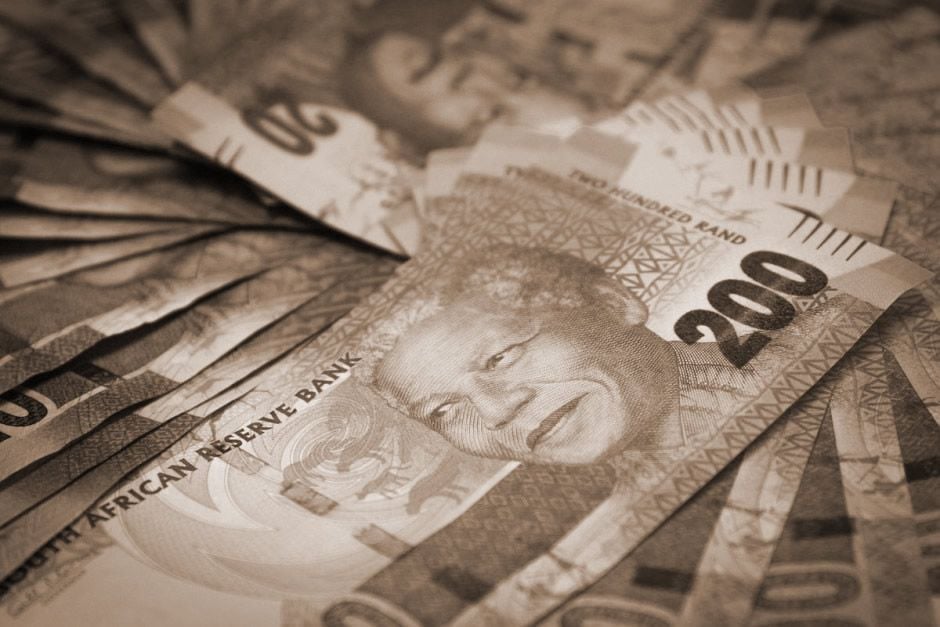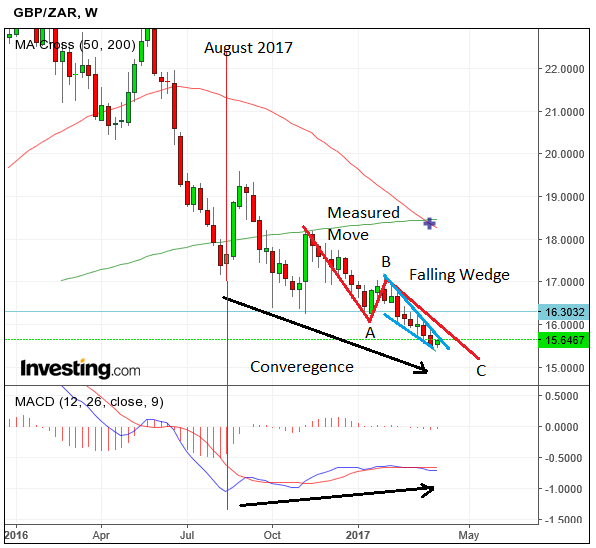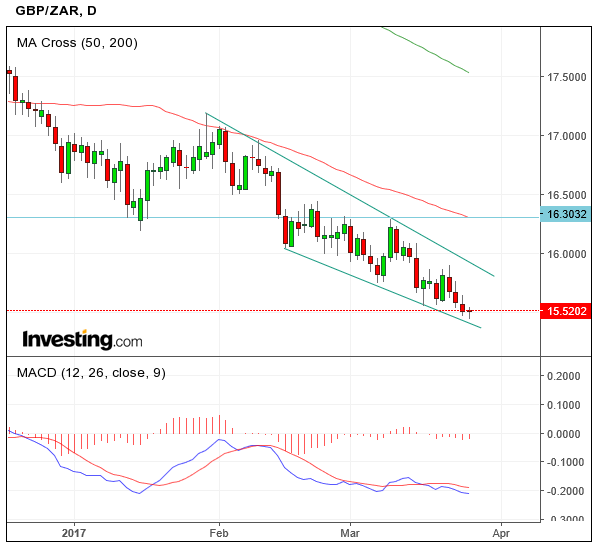5-Day Forecast for the Pound to South African Rand Exchange Rate

Just over a year ago, Sterling would have bought you 22.88 South African Rand; now you will only get 15.53 - a whole third less; to put the depreciation of the Pound into context.
Can the exchange rate get much lower?
From a purely technical perspective there is no hard evidence to suggest that it can’t, but there are signs the down-trend is getting a bit long in the tooth.
For starters, bearish momentum, as measured by MACD, appears to be weakening, especially on the weekly chart.

The MACD has not made lower lows in sync with price since the August 2016 lows and this non-corroboration (or “convergence” as techies call it) is often the precursor to a reversal in the trend.
Another sign is that the exchange rate may be forming a falling wedge pattern, which is a bullish pattern as after it finishes, it would be expected to break to the upside.
Finally, there is a measured move pattern currently playing out, which is basically a falling zig-zag where wave ‘A’ is normally roughly equal to wave ‘C’.
We are currently in ‘C’ which looks like it might have a little further to fall, but not much.
To signify we would ideally want to see a sudden bullish surge higher, out of the wedge.
A candlestick reversal pattern on the weekly chart would also be a good signal:

Without those, there is a risk of further Pound depreciation, especially given the probability that Theresa May is likely to trigger Article 50 this week (likely date March 29) and the symbolism of the event is more likely to be Sterling-negative than positive.
Nevertheless, the multitude of bearish indicators, despite not being definitive, mean we are cautious of forecasting much more downside too, so technically we remain neutral the pair.
The Week Ahead for the Rand
The main event for the Rand in the week ahead is the interest rate decision from the South African Reserve Bank (SARB) at 13.00 GMT on Thursday, March 30.
The consensus expectation is for the central bank to make no changes to the 7.0% base lending rate, but to strike a dovish tone, which means to imply there is more chance of a cut than a raise in the future.
Lloyds characterise the currency as extremely ‘vulnerable’ to outside shocks due to its high degree of external exposure and sensitivity to risk trends.
They also point to the continued threat of a credit rating downgrade of the country’s debt to junk status – an event that would cripple the Rand overnight.
Nevertheless, the same was said before the credit checks in December and they didn’t result in a downgrade despite a higher level of political risk permeating the economy at the time.
Research from Credit Suisse on the other hand focuses on the fact the currency has appreciated a whopping 7.0% since its last meeting on January 24, and this is likely to dispose the SARB to a rate cut to cap excessive appreciation of the currency than a rate hike which would make it even stronger.
An overly strong Rand stifles trade by making SA exports less competitive.
Credit Suisse also note the 30% fall in the prices of agricultural products since their peak in the summer of 2016 as a reason to remain cautious.
Such a decline hardly suggests the economy is sufficiently overheating for the SARB to see fit to increasing interest rates.
Week Ahead for the Pound
Theresa May’s triggering of Article 50 is likely to be the main event for Sterling in the coming week; and Wednesday 29 is a likely date.
“We expect GBP/USD to fall quickly when the announcement is made but it should recover swiftly when the inevitable happens and investors finally realise the negotiation process will be long and filled with delay,” says Kathy Lien, managing director at BK Asset Management.
Why Sterling would fall after the event is perplexing in our view - it is clearly well signposted and there is unlikely to be any new information on the outlook.
Any potential drivers for Sterling will come in the succession of events following the triggering of Article 50 - for instance, the Europeans laying out their proposed negotiating timetable. But event here we see little of substance to bother the Pound. It is only when negotiations get underway in earnest will Sterling move.
Analysts at Barclays meanwhile reckon that the triggering of Article 50 could potentially align with a longer-term recovery they expect Pound Sterling to undertake.
“We expect the triggering of Article 50 to initiate a ‘sell the rumour, buy the fact’ rebound in GBP from historic undervaluation as ambiguity over Brexit recedes,” says Marvin Barth, a foreign exchange analyst with Barclays bank in London.
Expect the European Commission to slap a divorce bill on Britain in the early stages of this whole process.
The Commission wants the UK to pay for all its outstanding spending commitments until 2020, which amounts to a bill of 50-60 billion Euros. Needless to say the UK does not agree with the figure.
Why would it the UK pay for a club it is no longer part of? Yes, these spending committments have been made, but they were made under the assumption that the UK would benefit from single market it is helping maintain via spending committments.
The EU wants this issue dealt with ahead of trade negotiations which suggests they don't want the UK to use the bill as a negotiating chip. Understandably, the UK wants the bill and negotiations to run concurrently.
We expect the tug-of-war over these various issues to potentially inject volatility into Sterling markets, but don't see any fundamental shift in direction resulting.
It is the trade negotiations that will be of utmost importance and these will only likely be tackled towards the end of 2017.
On the data front, it is a quiet week.
GDP data is out at 08.30 GMT on Friday March 31 but it is just a third and final revision and therefore highly unlikely to surprise. Growth for the final quarter 2016 is forecast to remain at the 0.7% announced by the ONS previously.
Mortgage Approvals, also out on Friday are not forecast to move much and thus seem unlikely to have much impact on the market.
